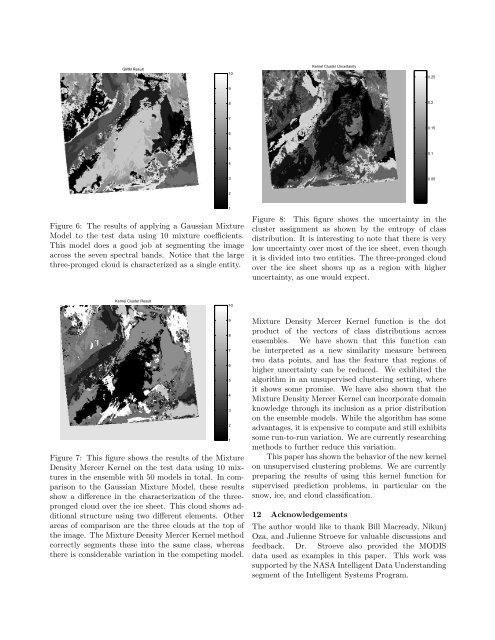Mixture Density Mercer Kernels - Intelligent Systems Division - NASA
Mixture Density Mercer Kernels - Intelligent Systems Division - NASA
Mixture Density Mercer Kernels - Intelligent Systems Division - NASA
Create successful ePaper yourself
Turn your PDF publications into a flip-book with our unique Google optimized e-Paper software.
GMM Result10Kernel Cluster Uncertainty0.25980.2760.1550.1430.052Figure 6: The results of applying a Gaussian <strong>Mixture</strong>Model to the test data using 10 mixture coefficients.This model does a good job at segmenting the imageacross the seven spectral bands. Notice that the largethree-pronged cloud is characterized as a single entity.1Figure 8: This figure shows the uncertainty in thecluster assignment as shown by the entropy of classdistribution. It is interesting to note that there is verylow uncertainty over most of the ice sheet, even thoughit is divided into two entities. The three-pronged cloudover the ice sheet shows up as a region with higheruncertainty, as one would expect.Kernel Cluster Result10Figure 7: This figure shows the results of the <strong>Mixture</strong><strong>Density</strong> <strong>Mercer</strong> Kernel on the test data using 10 mixturesin the ensemble with 50 models in total. In comparisonto the Gaussian <strong>Mixture</strong> Model, these resultsshow a difference in the characterization of the threeprongedcloud over the ice sheet. This cloud shows additionalstructure using two different elements. Otherareas of comparison are the three clouds at the top ofthe image. The <strong>Mixture</strong> <strong>Density</strong> <strong>Mercer</strong> Kernel methodcorrectly segments these into the same class, whereasthere is considerable variation in the competing model.987654321<strong>Mixture</strong> <strong>Density</strong> <strong>Mercer</strong> Kernel function is the dotproduct of the vectors of class distributions acrossensembles. We have shown that this function canbe interpreted as a new similarity measure betweentwo data points, and has the feature that regions ofhigher uncertainty can be reduced. We exhibited thealgorithm in an unsupervised clustering setting, whereit shows some promise. We have also shown that the<strong>Mixture</strong> <strong>Density</strong> <strong>Mercer</strong> Kernel can incorporate domainknowledge through its inclusion as a prior distributionon the ensemble models. While the algorithm has someadvantages, it is expensive to compute and still exhibitssome run-to-run variation. We are currently researchingmethods to further reduce this variation.This paper has shown the behavior of the new kernelon unsupervised clustering problems. We are currentlypreparing the results of using this kernel function forsupervised prediction problems, in particular on thesnow, ice, and cloud classification.12 AcknowledgementsThe author would like to thank Bill Macready, NikunjOza, and Julienne Stroeve for valuable discussions andfeedback. Dr. Stroeve also provided the MODISdata used as examples in this paper. This work wassupported by the <strong>NASA</strong> <strong>Intelligent</strong> Data Understandingsegment of the <strong>Intelligent</strong> <strong>Systems</strong> Program.
















